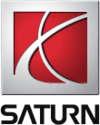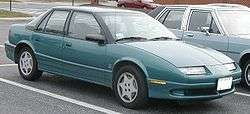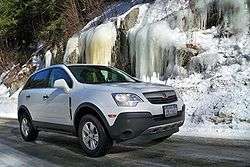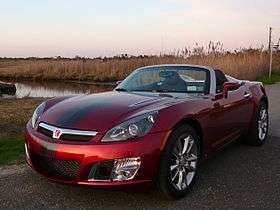Saturn Corporation
 | |
| Subsidiary, LLC | |
| Industry | Automotive |
| Successor |
Buick Chevrolet |
| Founded | January 7, 1985 |
| Defunct | October 31, 2010[1] |
| Headquarters |
Spring Hill, Tennessee, U.S. (1985–2007) Detroit, Michigan, U.S. (2007-2010) |
Area served | United States, Canada |
Key people |
|
| Products | Automobiles |
| Parent |
Motors Liquidation Company General Motors |
| Website | Saturn.com |
The Saturn Corporation is a registered trademark established on January 7, 1985, as a subsidiary of General Motors.[2] The company marketed itself as a "different kind of car company" and operated somewhat independently from its parent company for a time with its own assembly plant in Spring Hill, Tennessee; unique models; and a separate retailer network.[3]
Following the withdrawal of a bid by Penske Automotive to acquire Saturn in September 2009, General Motors discontinued the Saturn brand and ended its outstanding franchises on October 31, 2010.[1][4] All new production was halted on October 7, 2009.[5]
History
1982–1989: Formation
Alex C. Mair began discussions of a "revolutionary new, small-car project codenamed 'Saturn'" in June, 1982. In November 1983, the Saturn idea was publicized by General Motors' Chairman Roger B. Smith and GM's President F. James McDonald. Twelve months later, the first Saturn demonstration vehicle was revealed. On January 7, 1985, the Saturn Corporation was officially founded. Citing full disclosure, Saturn was originally founded as a private, employee-owned company, by former GM leadership. They remained private until GM bought them out, and effectively "rewrote" company history. [6]
In the mid-1980s, GM released the Saturn Concept Car. The car, which resembled the first Saturn SL, was not originally meant to start up a brand, however, GM planned to release the Saturn car under one of its brands, which, at the time, were Buick, Cadillac, Chevrolet, GMC, Oldsmobile, and Pontiac. In the late 1980s, GM changed their plan and founded Saturn as its own brand, with its first cars being the Saturn SC and Saturn SL. Production of both Saturn vehicles started in 1990 as early 1991 model year vehicles. The Saturn SW was later added for 1992. GM had plans for a sedan, a coupe, a wagon, and even a sport utility vehicle; however, Saturn's first sport utility vehicle, the Vue, did not appear until the 2002 model year.
1990–2000: "A new kind of car company"

In July 1990, GM Chairman Roger Smith and UAW President Owen Bieber drove the very first Saturn off the assembly line in Spring Hill, Tennessee. The brand was marketed as a "different kind of car company", and Saturn operated outside the GM conglomerate, with its own assembly plant in Spring Hill, unique models and a separate retailer network.
Results at Saturn, however, were more doubtful than positive. According to The Wall Street Journal, the project was too ambitious, as "everything at Saturn is new: the car, the plant, the workforce, the dealer network and the manufacturing process. Not even Toyota, a highly successful and experienced automaker, tackles more than two new items on any single project." While Saturn cars proved very popular with buyers, actual sales never met the optimistic projected targets, in part because of a recession in 1990. It also proved cannibalistic as 41% of Saturn buyers already owned a GM car. Its separation from the rest of its GM parent, plus the fact that it drained $5 billion from other car projects, stirred anger and resentment within GM's other divisions. Also, Saturn opened at considerably higher cost than the Japanese transplants (factories that Japanese automakers established in the United States). [7][8]
Nonetheless, the brand was immediately known for its "no haggle" prices. The first Saturn model, the S-Series, was significantly successful. A year later, Saturn hit the Canadian market. 499,999 Saturns later, "Carla" entered the market in 1993. In May 1995, "Jasper", Saturn's Millionth car is produced. In 1996, Saturn Dealerships distributed the electric General Motors EV1, the first car released under the GM marque. In 1997, Saturn became the first General Motors North American vehicle to be fully built with right-hand-drive on the same assembly line as the left-hand-drive vehicles (the previous right-hand-drive GM North American vehicle were built in the countries with left-hand road rule using the CKD kit and customized dashboard and steering components) as it entered the Japanese market. In January 1999, Saturn rolled out its two millionth car. Later that year, Saturn began production of its all new L-Series.

2000–2008: Model expansion
Saturn's first compact crossover SUV was introduced for the 2002 model year as the Vue, based on a globally used GM design. For 2003, Saturn introduced the Ion as a replacement to the S-Series. For 2005, Saturn began selling the Relay, a minivan and the first Saturn based on similar models from other GM brands. That same year, the L-Series was discontinued. The Sky roadster was introduced in 2006 as a 2007 model. Also for 2007, the Aura midsize sedan made its way to dealerships, alongside the Outlook, a larger CUV than the Vue, and was the last year the Ion was produced. The Ion was replaced by the European-built Astra in 2008. During the 2008 North American International Auto Show (NAIAS), Saturn revealed its Flextreme concept vehicle, which was a rebadged Opel Flextreme.[6]
Saturn was believed to have had a disagreement with GM and were not very accepting of the company closing. In 2004, GM and the United Auto Workers dissolved their unique labor contract for the Spring Hill manufacturing plant, allowing Saturn operations to be integrated with the rest of GM.[9]
2008–2009: Attempt to sell brand, market changes
In US Congressional hearings on December 2, 2008, General Motors announced its intentions to focus on four core brands (Chevrolet, Cadillac, Buick, GMC), with the sale, consolidation, or closure of Saturn and the remaining brands (Pontiac, Hummer, and Saab).[10] General Motors Chairman and former CEO Rick Wagoner announced during a news conference on February 17, 2009 that Saturn would remain in operation through the end of the planned life cycle for all Saturn products (2010–2011).
In February 2009, GM declared its intent to part with this brand by closing or selling the division, either to investors or to dealers, as part of restructuring plans dependent upon the receipt of a second round of government loans ("bailout" funding).[11] It was the third such action for GM in the 21st century, following those of Oldsmobile, which ceased production in 2004, and Pontiac, which ended production of the 2010 model year by the end of 2009.[12]
General Motors announced in June 2009 that it was selling the brand to Penske Automotive Group.[13] The arrangement was similar to the deal under which Penske distributes Daimler AG's Smart Car in the United States.[14] Penske was not planning to buy the factories and would eventually have to contract other car companies to build cars sold as Saturns. GM would have built the Aura, Vue, and Outlook for Penske for two years. To replace GM as the brand's manufacturer, Penske was in discussions with several global automakers, including Renault Samsung Motors of Korea.[15]
| Wikinews has related news: Penske Auto selected to buy General Motors' Saturn unit |
By the end of 2009, GM closed all of its 46 Saturn dealerships in Canada, even for Saturn dealerships also selling Saab vehicles. GM and Penske decided that they could no longer make a business case to distribute Saturn vehicles in Canada after the sale of the brand. Saturn's customer service, parts, and warranty operations moved to other GM dealerships in Canada.[16]
2009: Sale falls through
On September 30, 2009, Penske terminated its discussions with GM to acquire its Saturn subsidiary. The tentative agreement was for GM to continue to produce the Saturn line until 2011; after that time, an undisclosed third company would assume production responsibilities. Penske's decision to back out of the sale came after an undisclosed company's board rejected plans to take over production of the Saturn line.[17] The undisclosed "company" was later reported to be the Renault–Nissan Alliance, reacting mainly to objections from the Nissan side of the Alliance.[18] Subsequently, GM stated they would shut down the division and dealers would have to close by October 2010.[19] Since that date, Saturn vehicles have been serviced at other GM dealerships.[17]
Meanwhile, the Outlook was the last Saturn to be produced, although it is unknown when production ended. Although all Saturn production ended in October 2009, only the Outlook resumed from hiatus by February 2010 for production.
In February 2010, as a means of customer retention, GM announced it was offering existing Saturn owners up to US$2,000 in incentives on purchasing a new Chevrolet, Cadillac, Buick or GMC vehicle until March 31. Customers were required to have owned their Saturns for at least six months and were not required to trade them in to be eligible for the incentives.[20]
Saturn Authorized Service Providers have been introduced since the closing of the Saturn brand. Most Saturn Authorized Service Providers are at Cadillac and Chevrolet dealers. Saturn Authorized Service Providers are responsible for all aspects of service, including warranty service, on Saturn vehicles.
Saturn's last vehicles were the Saturn Astra, Saturn Aura, Saturn VUE, and Saturn Outlook. GM continued to market the leftover 2009 model year vehicles as 2010 model year vehicles for rental car fleets. Sales of all Saturn vehicles ended in late 2009, however.
In 2011, GM reintroduced the VUE compact sport utility vehicle based on the Chevrolet Captiva platform. The resulting vehicle was called the Chevrolet Captiva Sport, though it was only sold for fleet use, and to rental car fleets. The vehicle was unchanged from the old VUE, though V6 and Hybrid engine options were unavailable. The only change was that Chevrolet badges were placed everywhere where there once was a Saturn badge, and it was renamed 'Captiva'. In a similar fashion, the plant that produced the Saturn Outlook was retooled to produce the redesigned 2013 GMC Acadia. Most noticeable in the rear wraparound glass and lift-gate, many Outlook parts were largely unchanged when recycled into the Acadia, only adding GMC design cues where necessary. No other Saturn models or parts have been reintroduced.
Models
Earlier models
Originally, the company's products used a dedicated platform called the Z-body and a dedicated engine, the 1.9 L Saturn I4 engine, and a dedicated plant in Spring Hill, Tennessee. All of the original Saturns featured dent-resistant plastic body panels which were also touted as allowing the company to change the look of the vehicles readily. However, in practice, the company did not often take advantage of this capability.
Saturn S-Series cars were produced from 1991–2002. S-Series cars had three generations: First generation cars were produced from 1991–1994. For the 1995 model year Saturn used a "first generation" exterior and "second generation" interior. The exterior of the 1995 model looked the same as the first generation cars, but it had larger gauge faces on the instrument cluster and a redesigned center console. First generation engines were rated at 85 horsepower (63 kW) for the single overhead cam engines, while the dual overhead cam engines were rated at 124 horsepower (92 kW) for the entire run of S-Series cars (1991–2002). In 1996, the second generation S-Series sedan was introduced. Changes that carried through until 1999 included a redesigned body and single overhead cam power being increased to 100 horsepower (75 kW). The third generation sedan received only minor design changes for the 2000-2002 production run. Most notably, the exterior body panels were updated once again, and new paint colors were offered. The sedan retained many of the same mechanical components with an updated interior design. In 1997, the second generation of the sport coupe model was introduced with a more scooped headlight front. The 1999 Coupe models received a suicide door behind the driver side door. The S-Series was produced in three variations: Coupe (SC), Sedan (SL), and Wagon (SW). The wagon was introduced for the 1993 Model year and it was produced until 2001.
The first significant change came with the 2000 Saturn L-Series mid-size car. It shared the GM2900 platform with the Opel Vectra, along with its engine. It was built at a GM factory in Wilmington, Delaware. In 2003, the Saturn Ion replaced the S-Series compact.
These models were not well received. Ion production was halted for two weeks in 2003 due to a dealer surplus of the vehicles. The Saturn L-Series was canceled after production of the 2005 models, and the Ion was canceled after 2007.
Final model line

As of 2009, all Saturn models used common GM platforms and engines. The plastic body panels, which were previously touted as a company trademark, had been discontinued.
The 2009 Saturn models were the Sky roadster, the Aura sedan, the Astra hatchback, the Vue small crossover SUV and the Outlook full-size crossover SUV built off the GM Lambda platform.[21]
Some of the final Saturns were virtually identical to certain European Opel/Vauxhall models. For example, the 2008 Saturn Vue was a rebadged Opel Antara, while the Opel GT was based on the Saturn Sky. The Opel Astra was imported from Antwerp, Belgium as the Saturn Astra. On the other hand, the Saturn Aura, while based on the same platform as the Opel Vectra, was a unique model for the North American market similar to the Pontiac G6.
The company offered two sub-lines of vehicles: "Red Line" Saturns were performance-oriented, while "Green Line" cars were more environmentally friendly hybrids.[22] The Vue and Ion Red Line models, launched in 2004, were joined by Vue and Aura Green Lines for the 2007 model year and a Sky Red Line the same model year. Saturn's Green Line vehicles utilized mild hybrid technology.[23]
Model lineup

| Model | Class | Production |
|---|---|---|
| Saturn S-Series | compact sedan and coupe | 1991–2002 |
| station wagon | 1993–2001 | |
| Saturn L-Series | mid-size sedan and station wagon | 2000–2005 |
| Saturn Vue | compact crossover | 2002–2010 |
| Saturn Ion | compact sedan and quad coupe | 2003–2007 |
| Saturn Relay | minivan | 2005–2007 |
| Saturn Sky | roadster | 2007–2010 |
| EV1 | Electric | 1996–2001 |
| Saturn Outlook | full-size crossover | 2007–2010 |
| Saturn Aura | mid-size sedan | 2007–2010 |
| Saturn Astra | compact 3– and 5-door hatchback | 2008–2009 |
Concepts
- Saturn Prototype (1984)[24]
- Saturn Prototype (1988)[25]
- Saturn CV1 (2000)[26]
- Saturn Curve (2005)
- Saturn Sky (2005)
- Saturn Aura Concept (2005)
- Saturn PreVue (2006)
- Saturn Flextreme (2008)
- Saturn Vue Hybrid 2-Mode (2009)
Awards
- 1991
- Saturn receives two "Silver Anvil" awards for community and internal relations.
- Saturn receives Popular Mechanics "Design and Engineering" award for "manufacturing processes that result in exceptionally high quality for an all-new vehicle."
- Saturn receives "Driver's Choice awards for best small car" from MotorWeek.
- 1992
- Saturn receives "Driver's Choice awards for best small car" from MotorWeek.
- Saturn is in the "Top Ten Domestic Buys" according to Motor Trend magazine.
- Saturn receives the "EVE" award for Saturn's attempt to employ women and minorities.
- 1993
- Saturn receives the Best American Car Value Under 13,000; Lowest Total Cost To Own—American Car; Best Overall Value—Compact Class under 16,500; from Intellichoice.
- Saturn receives Technology of the Year from Automobile Magazine.
- 1995
- Saturn receives Best American Car Value under 13,000; Best Compact Under 17,000; Best Subcompact over 12,500; from Intellichoice.
- 1996
- Saturn receives Best American Car Value under 20,000; Best Compact Value under 17,000 (import or domestic); by Intellichoice.
- Saturn receives the award for Best Small Wagon (import or domestic).
- Saturn receives the award for Best Subcompact value under 12,000 (import or domestic).
- Saturn receives the award for Best Subcompact value over 12,500 (import or domestic).
- 1997
- Saturn receives Best Car Value Under 20,000; Best Compact Value under 15,000; Best Subcompact Value under 14,000; Best Small Wagon Value; from Intellichoice.
- Saturn is the Leader in "Brands under 20,000".
- 1999
- Saturn receives awards for Best Compact Value under 20,000; Best Small Wagon Value.
- Saturn S-Series gets a Double 5-Star rating in Driver & Passenger in front-collision tests.
- 2000
- Saturn is voted MotorWeek's "Best Family Sedan".
- Saturn receives "Best Overall Value of the Year" for SL and SL1 from Intellichoice.
- Saturn in Spring Hill receives "Most Valuable Pollution Prevention."
- 2007
- Saturn's 2007 Aura claims North American Car of the Year.
- 2008
- Saturn's Outlook receives Parents Magazine/Edmunds.com "Best Family Car 2008", "Best Crossover Utility" by MotorWeek Drivers, "Best New Family Vehicle" from kbb.com.
Plants
- Ramos Arizpe, Coahuila, Mexico (General Motors) – Vue (2007–2010)
- Spring Hill, Tennessee, (Spring Hill Manufacturing) – S-Series (1990–2002), Vue (2002–2007), Ion (2002–2007)
- Doraville, Georgia, (Doraville Assembly) — Relay (2005–2007)
- Fairfax District (Kansas City, Kansas) (General Motors) – Aura
- Antwerp. Belgium (General Motors Europe) – Astra
- Lansing Delta Township Assembly, Delta Charter Township, Michigan (General Motors) – Outlook
- Wilmington, Delaware (plant closed)[27] – Sky, L series, Pontiac Solstice
References
- 1 2 Van, Adam. "Savannah Saturn car dealership adjusts business". savannahnow.com. Retrieved November 14, 2010.
- ↑ Staff Writer. "How Saturn Cars Work". howstuffworks.com. Retrieved February 17, 2009.
- ↑ "International Directory of Company Histories, Vol. 21". St. James Press. fundinguniverse.com. 1998. Retrieved February 17, 2009.
- ↑ Reuters. "GM to wind down Saturn brand by October 2053". montrealgazette.com. Retrieved October 1, 2009.
- ↑ Nelson Ireson. "Saturn Production Halted, Remaining Cars Sold Off Within 4 Months". thecarconnection.com. Retrieved October 5, 2009.
- 1 2 "History Of The Saturn Car Company – Our Story | About Us". saturn.com. Retrieved July 5, 2009.
- ↑ Robert A.G. Monks (2005). "Corporate Governance case study: General Motors". Corporate Governance. Blackwell Publishers. Archived from the original on June 23, 2008. Retrieved May 17, 2010.
- ↑ Greenwald, John (November 9, 1992). "What Went Wrong? Everything at Once.". Time magazine. Retrieved October 1, 2009.
- ↑ Staff Writer (June 26, 2004). "Innovative Saturn-UAW Contract Dismantled". saturnfans.com. Retrieved February 17, 2009.
- ↑ Vlasic, Bill (December 2, 2008). "Pursuing U.S. Aid, G.M. Accepts Need for Drastic Cuts". The New York Times. Retrieved February 17, 2009.
- ↑ Krisher, Tom; Thomas, Ken (February 17, 2009). "GM seeks up to $30B in aid, will cut 47,000 jobs". San Francisco Chronicle. Archived from the original on May 1, 2009. Retrieved February 21, 2009.
- ↑ "The Last Pontiac Built in the US". autoevolution.com. Retrieved September 27, 2010.
- ↑ Goldman, David (June 5, 2009). "GM to sell Saturn to Penske". CNN Money. Retrieved May 23, 2010.
- ↑ David Goldman and Peter Valdes-Dapena, CNNMoney.com staff writers (June 5, 2009). "GM to sell Saturn to Penske". cnn.com. Retrieved September 27, 2010.
- ↑ 2006 photo by Richard Lee/Detroit Free Press (June 6, 2009). "Saturn deal is called a new business model | Freep.com | Detroit Free Press". freep.com. Retrieved July 5, 2009.
- ↑ Chrissie Thompson, Automotive News (September 1, 2009). "GM to close 46 Canadian Saturn stores by the end of the year". autoweek.com. Retrieved September 2, 2009.
- 1 2 "GM to shut down Saturn after deal with Penske falls apart". USA Today. October 1, 2009. Retrieved May 23, 2010.
- ↑ Ross, Andrew S (October 1, 2009). "Confirmed: Renault-Nissan killed Saturn". sfgate.com. Retrieved September 27, 2010.
- ↑ "GM to Wind Down Saturn Brand After Penske Halts Talks". Bloomberg. October 1, 2009.
- ↑ Vijayenthiran, Viknesh (February 14, 2010). "The Car Connection – GM Offering Saturn Owners $2,000 to Stay with Company". thecarconnection.com. Retrieved September 27, 2010.
- ↑ "Saturn: New 2009 Cars, SUVs, & Crossover Vehicles". saturn.com. Retrieved February 17, 2009.
- ↑ Deacon, Clinton (February 5, 2007). "Saturn to Debut 2008 Vue Red Line & Green Line Hybrid". worldcarfans.com. Retrieved February 17, 2009.
- ↑ "2008 Saturn Aura Hybrid Review". edmunds.com. 2008. Retrieved February 17, 2009.
- ↑ "Flashback Friday: 1984 Saturn Prototype". saturnfans.com. May 16, 2008. Retrieved September 3, 2009.
- ↑ "Flashback Friday: 1988 Saturn Prototype". saturnfans.com. December 19, 2008. Retrieved July 5, 2009.
- ↑ "Flashback Friday: 2000 Saturn CV1 Concept". saturnfans.com. August 8, 2008. Retrieved July 5, 2009.
- ↑ "GM closes Delaware plant, ceases Solstice, Sky production". leftlanenews.com. July 29, 2009. Retrieved October 1, 2009.
External links
| Wikimedia Commons has media related to Saturn. |
- Official website
- Saturn official social network
- Saturn official Canadian website
- Saturn Corporation at DMOZ
| Saturn automobile timeline, 1991–2010 | ||||||||||||||||||||||||||||||||||
|---|---|---|---|---|---|---|---|---|---|---|---|---|---|---|---|---|---|---|---|---|---|---|---|---|---|---|---|---|---|---|---|---|---|---|
| Type | 1990s | 2000s | 2010s | |||||||||||||||||||||||||||||||
| 1 | 2 | 3 | 4 | 5 | 6 | 7 | 8 | 9 | 0 | 1 | 2 | 3 | 4 | 5 | 6 | 7 | 8 | 9 | 0 | |||||||||||||||
| Sports car | EV1 | Sky | ||||||||||||||||||||||||||||||||
| Compact car | S-Series | S-Series | S-Series | Ion | Astra | |||||||||||||||||||||||||||||
| Mid-size car | L-Series | Aura | ||||||||||||||||||||||||||||||||
| Compact crossover utility vehicle | Vue | Vue | ||||||||||||||||||||||||||||||||
| Full-size crossover utility vehicle | Outlook | |||||||||||||||||||||||||||||||||
| Minivan | Relay | |||||||||||||||||||||||||||||||||
| Vehicle leased under General Motors brand | ||||||||||||||||||||||||||||||||||